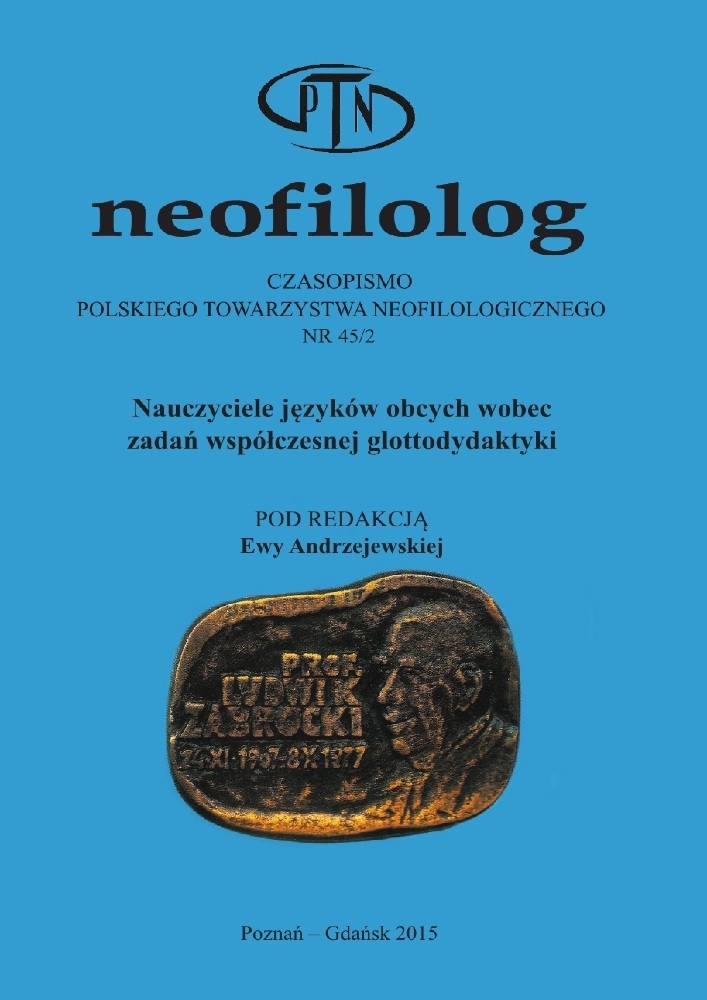Abstrakt
Looking for motivating concepts to stimulate integrated language andculture-related teaching and learning processes in the foreign language
classroom, the vibrant concept of Cultural Memory is certainly an issue
to pay attention to. It offers a variety of occasions for language and culture
awareness training tightly connected with language learning, reaching
far beyond traditional regional studies. Realms of memory, acting as
products and markers of a complex cultural memory, can reveal to what
extent (by whom, by which means, to what aims) cultural patterns and
meanings are constructed, how they change or under which circumstances
they survive long periods of time. Up-to-date foreign language
didactics can make use of this in aiming at symbolic competence (Claire
Kramsch). Understanding culture as an ongoing process of (de-and re-
)construction, learners might be enabled to notice and (partly) participate
in authentic discourses, going on in different languages. Realms of
memory, manifesting themselves per definition e.g. as texts, pictures,
sounds, buildings, historic or mythic persons, objects, terms or whole cultural
concepts, own a considerable linguistic and cultural potential. This
clearly points at content and process oriented learning processes involving
the foreign language as a natural means of exploration.
The article discusses criteria which might help to choose realms of
memory suitable for the foreign language classroom and takes a look at
two genuinely “German-speaking” examples in the field of sport (Córdoba
1978) and everyday objects (Schweizermesser). They can illustrate
the wide range of didactic possibilities and stimulating methods which
arise from authentic and vivid parts of a widely understood culture.
Bibliografia
Altmayer, C. 2004. Kultur als Hypertext. Zu Theorie und Praxis der Kulturwissenschaft im Fach Deutsch als Fremdsprache. München: Iudicium.
Assmann, A. 2009 [2007]. „Przestrzenie pamięci. Formy i przemiany pamięci kulturo-wej” [tłum. P. Przybyła] (w) Pamięć zbiorowa i kulturowa. Współczesna perspektywa niemiecka (red. M. Saryusz-Wolska). Kraków: Universitas: 101-142.
Badstübner-Kizik, C. 2013. „Inhaltsorientiertes Fremdsprachenlernen in medialen Um-gebungen“ (w) Fremdsprachenunterricht – omnimedial? (red. S. Chudak). Frank-furt a.M. Peter Lang: 33-45.
Badstübner-Kizik, C. 2014. „Erinnerungsorte in der fremdsprachlichen Kulturdidaktik. Anmerkungen zu ihrem didaktisch-methodischen Potenzial“ (w) Wege für Bil-dung, Beruf und Gesellschaft – mit Deutsch als Fremd- und Zweitsprache. 38. Jahrestagung des Fachverbandes Deutsch als Fremdsprache (red. N. Mackus, J. Möhring). Göttingen: Universitätsverlag: 43-64.
Badstübner-Kizik, C. 2015. „Über ,Erinnerungsorte‘ zur Vielfalt des deutschsprachigen Raumes“. Fremdsprache Deutsch 52: Landeskunde und kulturelles Lernen: 11-15.
Badstübner-Kizik, C. (w druku). „Heidi, Janosch und Otfried Preußler. Deutschsprachige Kinder- und Jugendliteratur als Erinnerungsort?“ (w) Sprache erleben und ler-nen mit Kinder- und Jugendliteratur II. Theorien, Modelle und Perspektiven für den Deutsch als Fremdsprachenunterricht (red. U. Eder). Wien: praesens.
Brix, E., Bruckmüller, E., Stekl, H. (red.). 2004/2005. Memoria Austriae. T I-III. München: De Gruyter Oldenbourg.
Erll, A. 2005. Kollektives Gedächtnis und Erinnerungskulturen. Eine Einführung. Stutt-gart: Metzler.
François, E., Schulze, H. (red.). 2003. Deutsche Erinnerungsorte. T I-III. München: C.H. Beck.
Friedrich, J. 2011. „Krzyżacy w niemieckiej i polskiej kulturze wizualnej” (w) Obok. Polska-Niemcy. 1000 lat historii w sztuce. Katalog wystawy (red. M. Omilanowska). Köln: Daumont: 104-109.
Górny, M., Hahn, H. H., Kończal, K., Traba, R. 2012. „Wprowadzenie” (w) Polsko-niemieckie miejsca pamięci. Tom 3: Paralele (red. H. H. Hahn, R. Traba). Warszawa: Scholar: 9-17.
Hahn, H. H., Traba, R. (red.). 2012. Polsko-niemieckie miejsca pamięci. Tom 3: Paralele. Warszawa: Scholar.
Kończal, K. 2013. „Miejsca pamięci. O niebywałej karierze pewnej koncepcji badawczej” (w) Polsko-niemieckie miejsca pamięci. T. 4: Refleksje metodologiczne (red. R. Traba i H.H. Hahn, współpraca M. Górny i K. Kończal). Warszawa: Scholar: 77-100.
Kramsch, C. 2011: „Symbolische Kompetenz durch literarische Texte“. Fremdsprache Deutsch 44: 35-40.
Kreis, G. 2010: Schweizer Erinnerungsorte. Aus dem Speicher der Swissness. Zürich: Verlag Neue Züricher Zeitung.
Loew, P. O., Traba, R. (red.). 2015. Deutsch-Polnische Erinnerungsorte. Band 5: Erinne-rung auf Polnisch. Paderborn: Verlag Ferdinand Schöningh.
Necel, R. 2009. „Doświadczenie tożsamości narodowej a współczesne gry sportowe. Mistrzostwa Europy w piłce nożnej w relacji tabloidów”. Homo Ludens 1: 205-212.
Omilanowska, M. (red.). 2011. Obok. Polska-Niemcy. 1000 lat historii w sztuce. Katalog wystawy. Köln: DuMont.
Poprzęcka, M. 2011. „Jana Matejki Bitwa pod Grunwaldem. Obrazu życie po życiu” (w) Obok. Polska-Niemcy. 1000 lat historii w sztuce. Katalog wystawy (red. M. Omilanowska). Köln: Daumont: 110-115.
Roche, J., Röhling, J. (red.). 2014. Erinnerungsorte und Erinnerungskulturen. Konzepte und Perspektiven für die Sprach- und Kulturvermittlung. Hohengehren: Schnei-der Verlag.
Sabrow, M. (red.). 2009. Erinnerungsorte der DDR. München: C. H.Beck.
Saryusz-Wolska, M. (red.). 2009. Pamięć zbiorowa i kulturowa. Współczesna perspektywa niemiecka. Horyzonty Nowoczesności. Tom 80 Kraków: Universitas.
Saryusz-Wolska, M., Traba, R. 2014. „Wprowadzenie” (w) Modi Memorandi. Leksykon kultury pamięci. (red. M. Saryusz-Wolska i R. Traba). Warszawa: Scholar: 13-30.
Saryusz-Wolska, M., Traba, R. (red.). 2014. Modi Memorandi. Leksykon kultury pamięci. Warszawa: Scholar.
Schmidt, S., Schmidt, K. (red.). 2007. Erinnerungsorte. Deutsche Geschichte im DaF-Unterricht. Berlin: Cornelsen.
Licencja
Prawa autorskie (c) 2019 Camilla Badstübner-Kizik

Utwór dostępny jest na licencji Creative Commons Uznanie autorstwa – Bez utworów zależnych 4.0 Międzynarodowe.
Przedstawiany utwór (artykuł) upubliczniany jest na podstawie umowy z autorem i na licencji Creative Commons Attribution-NoDerivatives 4.0 International (CC BY-ND 4.0).
Użytkownicy mają obowiązek podania wraz z rozpowszechnionym utworem, informacji o autorstwie, tytule, źródle (odnośniki do oryginalnego utworu, DOI) oraz samej licencji;
- bez tworzenia utworów zależnych,
- utwór musi być zachowany w oryginalnej postaci.
Uniwersytet im. Adama Mickiewicza w Poznaniu zachowuje prawo do czasopisma jako całości (układ, forma graficzna, tytuł, projekt okładki, logo itp.).
